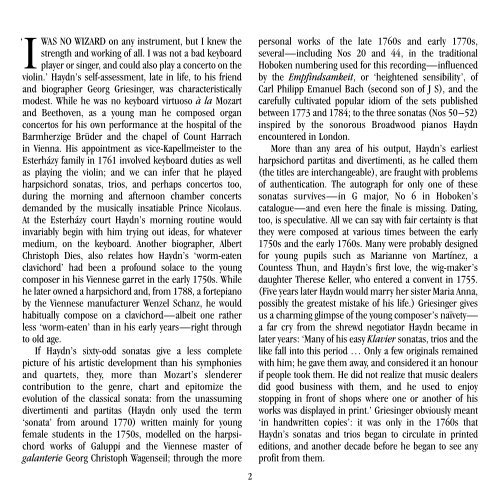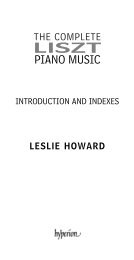Téléchargez le livret intégral en format PDF ... - Abeille Musique
Téléchargez le livret intégral en format PDF ... - Abeille Musique
Téléchargez le livret intégral en format PDF ... - Abeille Musique
Erfolgreiche ePaper selbst erstellen
Machen Sie aus Ihren PDF Publikationen ein blätterbares Flipbook mit unserer einzigartigen Google optimierten e-Paper Software.
‘<br />
I<br />
WAS NO WIZARD on any instrum<strong>en</strong>t, but I knew the<br />
str<strong>en</strong>gth and working of all. I was not a bad keyboard<br />
player or singer, and could also play a concerto on the<br />
violin.’ Haydn’s self-assessm<strong>en</strong>t, late in life, to his fri<strong>en</strong>d<br />
and biographer Georg Griesinger, was characteristically<br />
modest. Whi<strong>le</strong> he was no keyboard virtuoso à la Mozart<br />
and Beethov<strong>en</strong>, as a young man he composed organ<br />
concertos for his own performance at the hospital of the<br />
Barmherzige Brüder and the chapel of Count Harrach<br />
in Vi<strong>en</strong>na. His appointm<strong>en</strong>t as vice-Kapellmeister to the<br />
Esterházy family in 1761 involved keyboard duties as well<br />
as playing the violin; and we can infer that he played<br />
harpsichord sonatas, trios, and perhaps concertos too,<br />
during the morning and afternoon chamber concerts<br />
demanded by the musically insatiab<strong>le</strong> Prince Nicolaus.<br />
At the Esterházy court Haydn’s morning routine would<br />
invariably begin with him trying out ideas, for whatever<br />
medium, on the keyboard. Another biographer, Albert<br />
Christoph Dies, also relates how Haydn’s ‘worm-eat<strong>en</strong><br />
clavichord’ had be<strong>en</strong> a profound solace to the young<br />
composer in his Vi<strong>en</strong>nese garret in the early 1750s. Whi<strong>le</strong><br />
he later owned a harpsichord and, from 1788, a fortepiano<br />
by the Vi<strong>en</strong>nese manufacturer W<strong>en</strong>zel Schanz, he would<br />
habitually compose on a clavichord—albeit one rather<br />
<strong>le</strong>ss ‘worm-eat<strong>en</strong>’ than in his early years—right through<br />
to old age.<br />
If Haydn’s sixty-odd sonatas give a <strong>le</strong>ss comp<strong>le</strong>te<br />
picture of his artistic developm<strong>en</strong>t than his symphonies<br />
and quartets, they, more than Mozart’s s<strong>le</strong>nderer<br />
contribution to the g<strong>en</strong>re, chart and epitomize the<br />
evolution of the classical sonata: from the unassuming<br />
divertim<strong>en</strong>ti and partitas (Haydn only used the term<br />
‘sonata’ from around 1770) writt<strong>en</strong> mainly for young<br />
fema<strong>le</strong> stud<strong>en</strong>ts in the 1750s, model<strong>le</strong>d on the harpsi -<br />
chord works of Galuppi and the Vi<strong>en</strong>nese master of<br />
galanterie Georg Christoph Wag<strong>en</strong>seil; through the more<br />
2<br />
personal works of the late 1760s and early 1770s,<br />
several—including Nos 20 and 44, in the traditional<br />
Hobok<strong>en</strong> numbering used for this recording—influ<strong>en</strong>ced<br />
by the Empfindsamkeit, or ‘height<strong>en</strong>ed s<strong>en</strong>sibility’, of<br />
Carl Philipp Emanuel Bach (second son of J S), and the<br />
carefully cultivated popular idiom of the sets published<br />
betwe<strong>en</strong> 1773 and 1784; to the three sonatas (Nos 50–52)<br />
inspired by the sonorous Broadwood pianos Haydn<br />
<strong>en</strong>countered in London.<br />
More than any area of his output, Haydn’s earliest<br />
harpsichord partitas and divertim<strong>en</strong>ti, as he cal<strong>le</strong>d them<br />
(the tit<strong>le</strong>s are interchangeab<strong>le</strong>), are fraught with prob<strong>le</strong>ms<br />
of auth<strong>en</strong>tication. The autograph for only one of these<br />
sonatas survives—in G major, No 6 in Hobok<strong>en</strong>’s<br />
catalogue—and ev<strong>en</strong> here the fina<strong>le</strong> is missing. Dating,<br />
too, is speculative. All we can say with fair certainty is that<br />
they were composed at various times betwe<strong>en</strong> the early<br />
1750s and the early 1760s. Many were probably designed<br />
for young pupils such as Marianne von Martínez, a<br />
Countess Thun, and Haydn’s first love, the wig-maker’s<br />
daughter Therese Kel<strong>le</strong>r, who <strong>en</strong>tered a conv<strong>en</strong>t in 1755.<br />
(Five years later Haydn would marry her sister Maria Anna,<br />
possibly the greatest mistake of his life.) Griesinger gives<br />
us a charming glimpse of the young composer’s naïvety—<br />
a far cry from the shrewd negotiator Haydn became in<br />
later years: ‘Many of his easy Klavier sonatas, trios and the<br />
like fall into this period … Only a few originals remained<br />
with him; he gave them away, and considered it an honour<br />
if peop<strong>le</strong> took them. He did not realize that music dea<strong>le</strong>rs<br />
did good business with them, and he used to <strong>en</strong>joy<br />
stopping in front of shops where one or another of his<br />
works was displayed in print.’ Griesinger obviously meant<br />
‘in handwritt<strong>en</strong> copies’: it was only in the 1760s that<br />
Haydn’s sonatas and trios began to circulate in printed<br />
editions, and another decade before he began to see any<br />
profit from them.
















